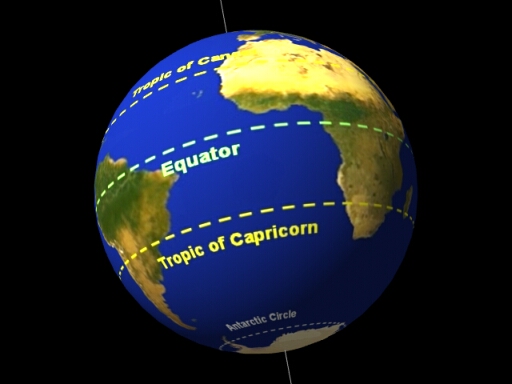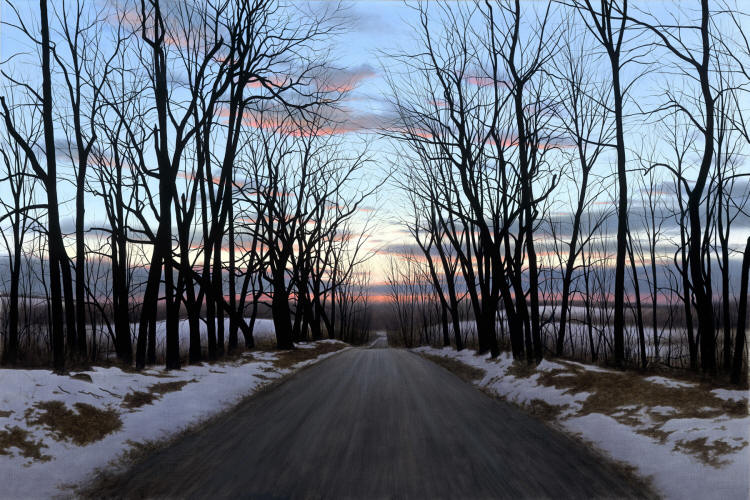Problem:

How does the tilt of Earth’s axis affect the light received by Earth as it revolves around the sun?
Hypothesis:
As the earth tilts towards the sun the light received is directed toward the earth making one hemisphere summer and the other hemisphere winter.
Hypothesis:
As the earth tilts towards the sun the light received is directed toward the earth making one hemisphere summer and the other hemisphere winter.
Materials:
· -books
· -flashlight
· -paper
· -pencil
· -protractor
· -toothpick
· -acetate sheet with thick grid lines drawn on it
Procedure
1. Make a pile of books about 15 cm high
2. Tape the acetate sheet to the head of the flashlight. Place the flashlight on eh pile of books.
3. Carefully push a pencil into the South Pole of the plastic foam ball, which represents Earth.
4. Use the protractor to measure a 23.5 tilt of the axis of your Earth away from your “flashlight sun,” as shown in the top diagram. This position represents winter in the Northern Hemisphere/.
5. Hold the pencil so that Earth is steady as this 23.5 angle and about 15 cm from the flash-light head. Turn the flashlight on. Dim the room lights.
6. The squares on the acetate should show up on your model Earth. Move the ball closer if necessary of dim the room lights more. Observe and record the shape of the squares at the equator and at the poles.
7. Carefully stick the toothpick straight into your model Earth about halfway between the equator and the North Pole. Observe and record the length of the shadow
8. Without changing the tilt, turn the pencil to rotate the model Earth once on its axis. Observe and record how the shadow of the tooth picks changes.
9. Tilt your model Earth 23.5 toward the flashlights, as shown in the bottom diagram. This is summer in the Northern Hemisphere. Observe and record the shape of the squares at the equator and at the poles. Observe how the toothpick’s shadow changes.
Observations:

When looking at the globe with the longitudinal/latitude lines the light stretches the lines to fit the globe. In the center of the globe around the equator the squares are equal boxes. Around the Northern Hemisphere and the Southern Hemisphere the boxes are longer because the light stretches them.
Toothpick observations: During Winter

When the Earth is tilted away from the sun the shadow from the toothpick is about 1 cm long. It is a
very distinct shadow. When the Earth is in its rotation throughout the day the length of the shadow changes. The shadow is at longest stretch when in the middle of the day. As it turns away from the light (almost dusk) this means that the shadow gets shorter before going into complete darkness (nighttime). As the Earth’s rotation turns toward the sun the shadow gradually becomes longer because it receives more sunlight (early morning). Then at the middle of the day- 12:00 pm it is at its longest stretch. After that shadow recedes.

Toothpick observations: During Summer
When in the summer the Northern Hemisphere gets the most amount of sunlight because the Earth is tilted towards it. Just like in winter, as the toothpick/earth turn towards the sun a shadow appears. It gets longer throughout the day, however the shadow that the toothpick produces is significantly longer that the shadow in the winter. This is because again the light is directed at the Northern Hemisphere. In the middle of the day the shadows is the longest because that is the time when it gets the most directed sunlight.

Analyze and Conclude
1. When it is winter in the Northern Hemisphere, which areas on the Earth get the most concentrated light? Which areas get the most concentrated light when it is summer in the Northern Hemisphere?
In the winter of the Northern Hemisphere the areas on the Earth that get the most light are areas around the equator. Areas around the equator have a lot of direct sunlight even when it is winter or summer. In the summer of the Northern Hemisphere the light is directed a little more above the equator meaning more of the Northern Hemisphere gets heat. In the winter the light is a directed a little below the equator, which means that the people in the Southern Hemisphere get more sunlight than the Northern Hemisphere people.

2. Compare your observations of how the light hits the area halfway between the equator and the North Pole during winter and during summer.
During the summer months the shadow is a lot longer, which means that there is more sunlight directed at that area. When doing the experiment I observed that the shadow line was significantly longer than in the winter months. In the winter the shadow is shorter because there isn’t a lot of concentrated sunlight, which means a shorter shadow.

3. According to your observations, which areas on Earth are consistently coolest? Which areas are consistently warmest? Why?
On Earth, places that are consistently cool are the poles. This is because they do not get a directed amount of sunlight, if it does it's only for a short period of time because the of the rotation of the Earth. The areas on Earth that are consistently the warmest are countries around the equator. This is because the equator gets the most amount of directed sunlight.

4. What time of year will the tooth pick’s shadow be the longest? When will the shadow be shortest?
In the winter the toothpick’s shadow is very short, and in the summer the shadow is very long. This is because of the limited amount of sunlight we have in the winter. This is the reason why we have daylight savings time, because we want to save our precious daylight in the winter. We go back to standard time in the summer because we have enough sunlight so we don’t need to save the light. In the summer the days are long, and in winter the days are short.

5. What time of year will the toothpick’s shadow be longest? When will the shadow be shortest?
In the winter the shadow will be the shortest, and in the summer the shadow will be the longest. This is because in the summer the days are long and the days in winter are short.

6. How are the amounts of heat and light received in a square related to the angle of the sun’s rays?
The square grids represent how much heat and light that are received in a designated area on Earth. With the grid we can have a small picture of where on earth the sun hits the most.

7. Use your observations of an Earth-sun model to write and explanation of what causes the seasons.
The seasons are separated into two dominate seasons and two less dominate seasons. Winter and summer are the very dominate seasons, during a year the earth tilts either towards the sun or away from the sun. During the winter both hemispheres have a short amount of daylight, in the summer the days are longer. Seasons are created because of the Earth’s rotation and revelation, without this one part of the earth would be lifeless and the other part would be sun baked. Seasons are very important to us now and especially thousands of years ago. The change between summer, fall, winter, and spring provided the creation of farming and the calendar. Without seasons there would no reason to be on this planet because it is useless. What is important about seasons is that we learned about them thousands of years ago so we know have advanced knowledge about how seasons work.

Further Inquiry
I was thinking about Global Warming today while I was completing this experiment. I wonder if Global Warming is caused not only by green house gasses but also the slowed of the earth’s revolution around the sun. I doubt that that is really what is triggering it, but it would be interesting to look into. This year winter didn’t really start until late December, the weather was really nice, and now it is May and it feels like March weather. It is weird weather, I hope we figure out the answer before it is too late.
Seasons:
This is a great video about the basics of seasons- the narrator has a slow voice so it is perfect for studying.




No comments:
Post a Comment